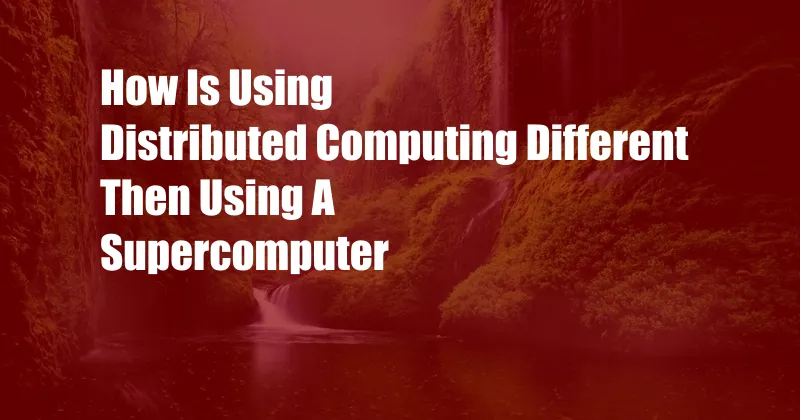
How is Using Distributed Computing Different from Using a Supercomputer?
In the realm of computing, the quest for greater processing power has led to the development of both distributed computing and supercomputers. While both approaches harness multiple computing resources, they operate in distinct ways, catering to different computational needs.
To delve into the intricacies of distributed computing, we’ll explore its history, its key characteristics that distinguish it from supercomputers, and its burgeoning applications within modern technology.
Distributed Computing: A Collective Approach
Distributed computing, as the name suggests, involves the distribution of computational tasks across multiple interconnected computers or nodes linked through a network. These nodes collaborate seamlessly, sharing resources and data to accomplish a common goal.
Unlike supercomputers, distributed computing systems are typically composed of commodity hardware. This decentralized architecture offers inherent advantages in terms of cost-effectiveness and scalability. Additionally, distributed computing systems are less susceptible to single-point failures, as the workload can be dynamically redistributed if one node encounters an issue.
Supercomputers: Centralized Powerhouses
In contrast to distributed computing, supercomputers centralize their computational resources within a single massive system. They are purpose-built, utilizing specialized hardware and high-performance interconnects to maximize raw computing power.
Supercomputers excel in scenarios that demand intense computational horsepower for complex simulations and modeling applications. Their tightly integrated architecture enables rapid communication and data transfer, facilitating efficient processing of large datasets.
Applications and Trends in Distributed Computing
Distributed computing has become ubiquitous in modern technology, underpinning a wide range of applications:
- Cloud computing services provide virtualized resources and applications accessible over the Internet.
- High-throughput computing enables the processing of massive datasets for scientific research and analytics.
- Peer-to-peer networks leverage distributed computing for file sharing and decentralized applications.
Recent advancements in distributed computing include the emergence of edge computing, which brings computation closer to the data sources at the network edge, and serverless computing, which allows developers to execute code without managing the underlying infrastructure.
Expert Advice for Harnessing Distributed Computing
To effectively utilize distributed computing, consider the following expert advice:
- Choose the Right Architecture: Identify the appropriate distributed computing model (e.g., cloud computing, peer-to-peer) that aligns with your computational requirements.
- Optimize Data Management: Design efficient strategies for data distribution, replication, and synchronization across nodes to enhance performance and reliability.
By adhering to these guidelines, you can harness the transformative power of distributed computing and unlock new possibilities in high-performance computing.
FAQs on Distributed Computing
- Q: What are the main advantages of distributed computing?
- A: Scalability, cost-effectiveness, resilience, and access to specialized resources.
- Q: What types of applications are suited for distributed computing?
- A: Data-intensive processing, scientific simulations, image processing, and machine learning.
- Q: How can I get started with distributed computing?
- A: Utilize cloud computing services, experiment with open-source distributed computing frameworks, or consult with a distributed computing expert.
Conclusion
Distributed computing and supercomputers represent distinct approaches to high-performance computing, each with its own strengths and applications.
Distributed computing offers scalability, cost-effectiveness, and resilience, making it suitable for a myriad of applications in cloud computing, data analytics, and artificial intelligence. Supercomputers, on the other hand, provide unparalleled raw computing power, cater to specialized scientific and research domains, and are pivotal for pushing the boundaries of human knowledge.
Ultimately, the choice between distributed computing and supercomputers hinges on the specific computational needs of your project. By understanding the nuances of both approaches, you can harness their respective capabilities to drive innovation and progress in your field.
Are you interested in learning more about distributed computing and its applications? Explore our website for additional resources and insights.